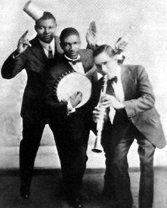talking history | syllabi | students | teachers | puzzle | about us
The Red Hot Jazz Archive: A History of Jazz before 1930
http://www.redhotjazz.com
Created and maintained by Scott Alexander.
Reviewed June 2002.
The Red Hot Jazz Archive illustrates the advent of multimedia “amateur” jazz history. Nonacademic jazz fans have produced most of the extant jazz histories, biographies, and discographies, and now one of them, Scott Alexander, has built a fine and substantial Web site that is not just for aficionados. Red Hot Jazz allows all types of jazz scholars to explore and ponder more deeply the music�s early history, and, more important, it introduces history students to a trove of rich and enjoyable primary sources.

A typical band page in the Red Hot Jazz Archive
describes a little-known 1920s combo, the Chicago Hottentots,
listing its personnel and recordings.
On the introductory page Alexander gives a short history of jazz from 1890 to 1935. The site is “an experiment,” "a work in progress“ intended to be a ”valuable and enjoyable tool for appreciating [early jazz] and the men and women who produced it." The bulk of Red Hot Jazz is accessed through two links on a toolbar: “Bands” and “Musicians.” The first page is an enormous index of over seven hundred bands active in the 1920s and 1930s, featuring the well-known ensembles of Louis Armstrong, Jelly Roll Morton, and others, as well as little-known groups such as Zack Whyte and His Chocolate Beau Brummels, Boyd Senter and His Senterpedes, and Rubin “River” Reeves and His Tributaries. Most pages feature a brief band history and lists of personnel and recorded musical numbers. For most bands, some or all of the listed recordings are linked to Real Audio sound files. Thousands of records, many very rare, may be heard here (but not downloaded). To give only one example, there are two numbers recorded in Paris in 1929 by Jean Cocteau and “l’orchestre Dan Parrish,” featuring the surrealist poet reading his work to a jazz accompaniment.
The musician pages, over 150 in number, mostly cover better-known figures, although now-obscure musicians such as the cornetist Thomas Morris, the bandleader Tiny Parham, and the blues singers Margaret Johnson, Lucille Hegamin, and Esther Bigeou are also included. The pages are extensively hyperlinked, and the site�s server computer delivers the music files without blemishes. The “Films” page, though, is definitely still a work in progress. It lists jazz shorts from the early talkie era, but only two such films are hyperlinked, and neither ran successfully on the required movie software (which costs thirty dollars to download). A basic search engine is also featured. The main value of Red Hot Jazz is clearly its extraordinary collection of complete 78-rpm recording sides.
Alexander reprints much published material in his capsule biographies and on an “Essays” page, but he offers no notices of permission granted by authors or publishers. Permissions are not listed for the music files either. “Many people have asked if the Red Hot Jazz Archive is legal,” Alexander acknowledges in his introduction, and he can only provide a tenuous self-defense based on current copyright law. This casual approach to permissions may cause difficulty for the site in the future. In the meantime, though, instructors who provide students with the proper historical context will find that Red Hot Jazz can enrich class study of an extraordinary chapter in American music and social history. For scholars, it is the most accessible collection of early jazz sound reproductions and band information on the Web, a big jukebox that will certainly inspire deeper research into particular groups, individuals, regions, styles, and topics from the early jazz age.
Burton W. Peretti
Western Connecticut State University
Danbury, Connecticut
